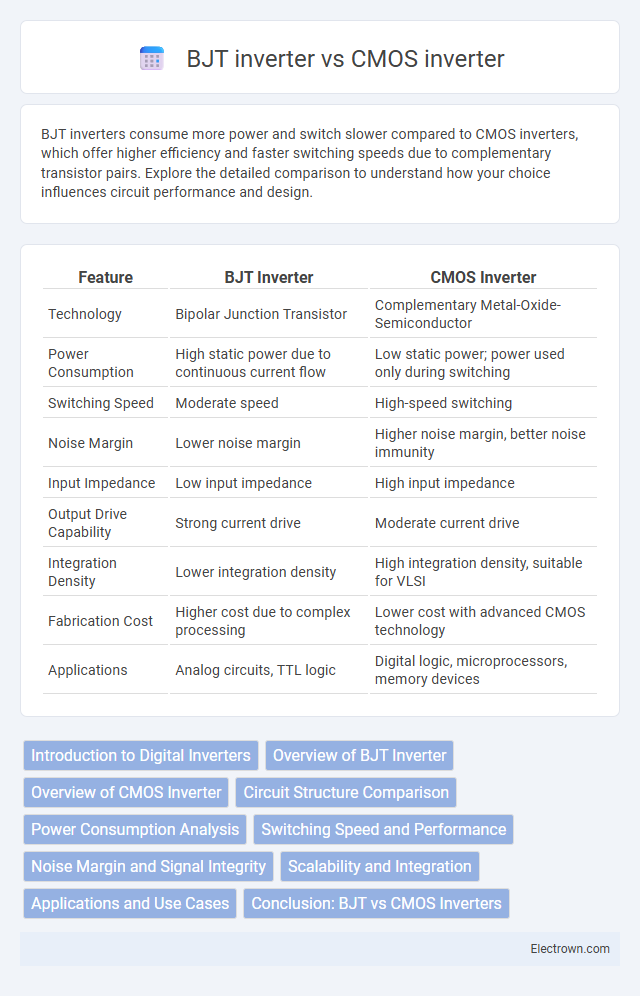BJT inverters consume more power and switch slower compared to CMOS inverters, which offer higher efficiency and faster switching speeds due to complementary transistor pairs. Explore the detailed comparison to understand how your choice influences circuit performance and design.
Table of Comparison
| Feature | BJT Inverter | CMOS Inverter |
|---|---|---|
| Technology | Bipolar Junction Transistor | Complementary Metal-Oxide-Semiconductor |
| Power Consumption | High static power due to continuous current flow | Low static power; power used only during switching |
| Switching Speed | Moderate speed | High-speed switching |
| Noise Margin | Lower noise margin | Higher noise margin, better noise immunity |
| Input Impedance | Low input impedance | High input impedance |
| Output Drive Capability | Strong current drive | Moderate current drive |
| Integration Density | Lower integration density | High integration density, suitable for VLSI |
| Fabrication Cost | Higher cost due to complex processing | Lower cost with advanced CMOS technology |
| Applications | Analog circuits, TTL logic | Digital logic, microprocessors, memory devices |
Introduction to Digital Inverters
Digital inverters convert input logic signals to their opposite output states, essential in digital circuits for signal processing and logic operations. BJT inverters rely on bipolar junction transistors to switch between high and low output levels, offering faster switching speeds but higher power consumption compared to CMOS inverters. CMOS inverters use complementary MOSFETs, providing low static power dissipation and high noise immunity, which makes them ideal for battery-powered and large-scale integration applications.
Overview of BJT Inverter
A BJT inverter utilizes bipolar junction transistors to switch voltage levels, providing high gain and fast switching speeds ideal for analog and digital circuits. This type of inverter operates by driving the BJT into saturation and cutoff regions, resulting in distinct logic levels and reliable signal inversion. Despite higher power consumption compared to CMOS inverters, BJT inverters deliver superior current driving capability and robustness in temperature variations.
Overview of CMOS Inverter
CMOS inverter consists of complementary MOSFETs--an n-channel and a p-channel transistor--arranged in a push-pull configuration to efficiently switch between logic states with minimal power dissipation. Its key advantage over BJT inverter lies in significantly lower static power consumption and higher noise margins, making it ideal for modern digital circuits. You benefit from improved scalability and reduced heat generation, enhancing overall system reliability and performance.
Circuit Structure Comparison
BJT inverters consist of bipolar junction transistors that rely on current-driven operation, with a simpler two-terminal circuit structure typically involving a single transistor and resistor. CMOS inverters use complementary pairs of p-type and n-type MOSFETs, providing a more complex but power-efficient push-pull stage that significantly reduces static power consumption. Your choice between BJT and CMOS inverter circuits hinges on the trade-off between simplicity and power efficiency in the overall design structure.
Power Consumption Analysis
BJT inverters typically consume more power due to continuous current flow through the transistor even in the off state, leading to higher static power dissipation. CMOS inverters have significantly lower power consumption as they only draw substantial current during switching transitions, resulting in minimal static power usage. Your choice between BJT and CMOS inverters should consider the power efficiency advantages of CMOS technology in modern low-power applications.
Switching Speed and Performance
BJT inverters generally exhibit faster switching speeds due to higher transconductance and quicker charge carrier mobility compared to CMOS inverters, which rely on complementary MOSFETs with slower electron and hole mobility. However, CMOS inverters provide superior performance in terms of power efficiency and noise margins, making them more suitable for integrated circuits with high-density logic gates. The trade-off between BJT's speed and CMOS's low power consumption drives the choice depending on application requirements such as high-frequency analog circuits versus low-power digital systems.
Noise Margin and Signal Integrity
BJT inverters typically exhibit lower noise margins compared to CMOS inverters due to higher static power dissipation and threshold voltage variability, which can compromise signal integrity in noisy environments. CMOS inverters offer superior noise margins and better signal integrity thanks to their high input impedance and low static power consumption, making them more robust for digital circuit applications. Your design will benefit from CMOS technology when prioritizing noise immunity and stable signal transitions.
Scalability and Integration
CMOS inverters offer superior scalability and integration capabilities compared to BJT inverters due to their lower power consumption and smaller transistor sizes, enabling higher density on integrated circuits. CMOS technology supports advanced fabrication processes, making it ideal for complex, large-scale digital systems. You benefit from CMOS inverter's compatibility with modern VLSI designs, ensuring efficient performance and seamless integration in your electronic applications.
Applications and Use Cases
BJT inverters excel in high-speed switching applications and are commonly used in analog circuits such as oscillators and amplifiers due to their strong drive capability. CMOS inverters dominate digital logic circuits, offering low power consumption and high noise immunity, making them ideal for microprocessors, memory devices, and battery-operated systems. Your choice between BJT and CMOS inverter depends on the required trade-off between power efficiency and switching speed in the intended application.
Conclusion: BJT vs CMOS Inverters
BJT inverters exhibit faster switching speeds and higher gain but consume more power compared to CMOS inverters, which offer low power consumption and high noise immunity. CMOS inverters are preferred in modern digital circuits due to their efficiency and scalability, making them ideal for battery-powered and integrated applications. Your choice depends on whether speed or power efficiency is the priority in your specific electronic design.
BJT inverter vs CMOS inverter Infographic

 electrown.com
electrown.com